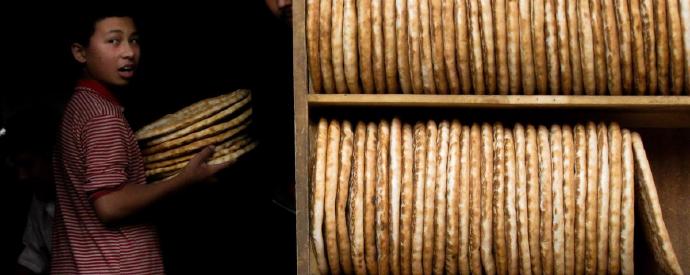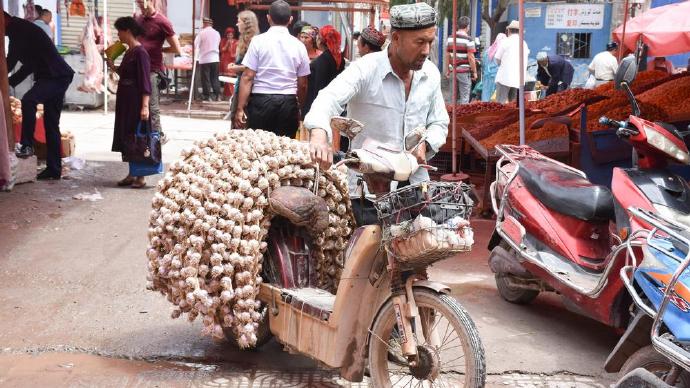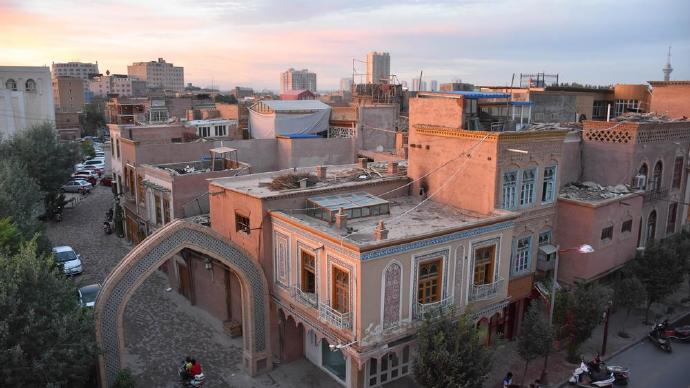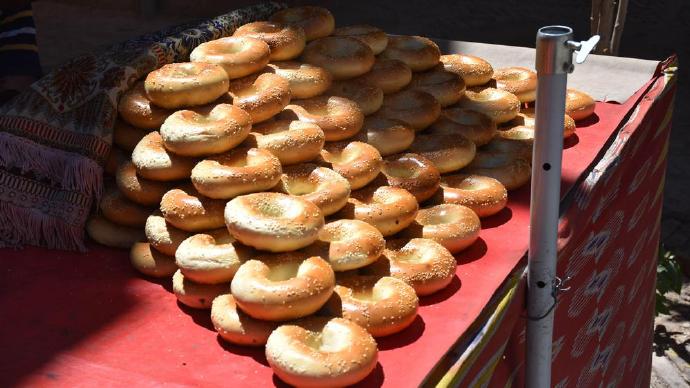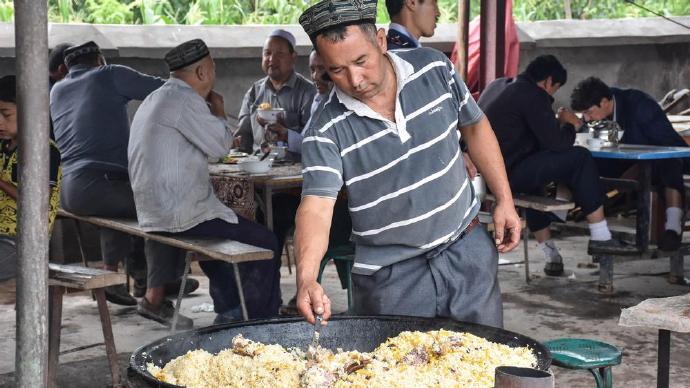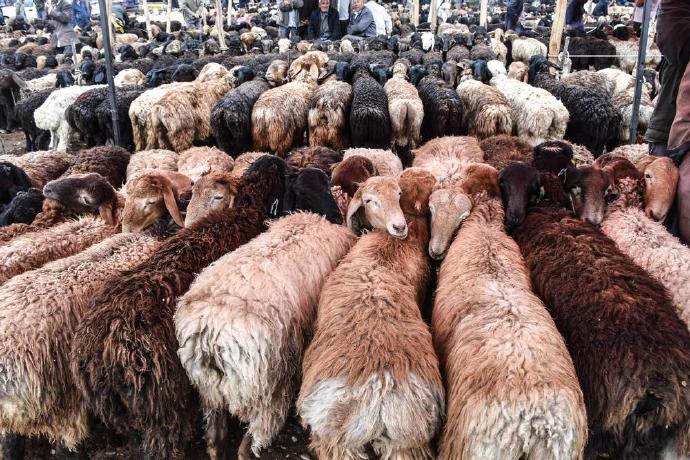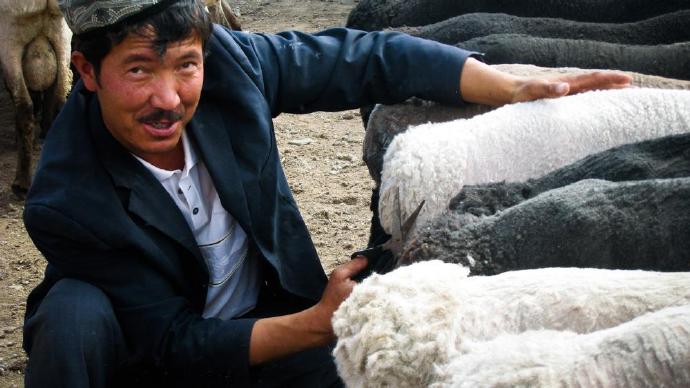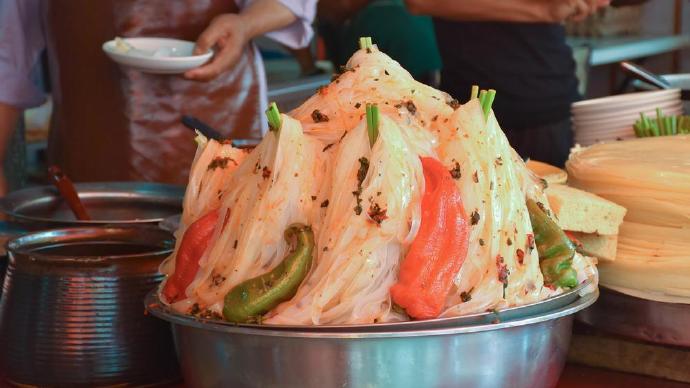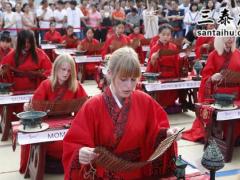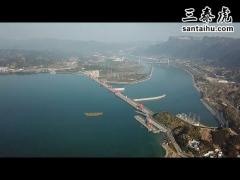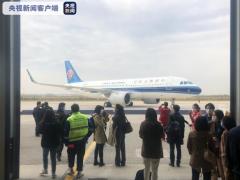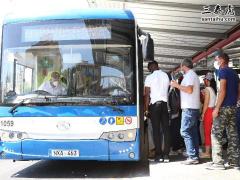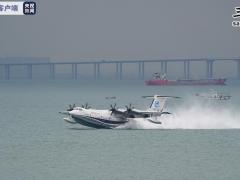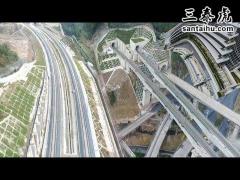弥漫着骆驼奶和羊汤气息的中国集市 [美国媒体]
喀什格尔给人的感觉并不那么“中国”。泥砖堆砌成的房子装饰着带花纹的黄铜门环,闪亮的绿色瓷砖铺设其上,配上描绘过的拱门,看上去与其说是中式建筑,不如说更像是一个突厥风格的城市。街道上,小贩们兜售着一串串烤乳鸽和一叠叠烤馕(看起来很像面包圈,但是硬得和石头一样)。自制奶酪和牦牛酸奶更是应有尽有。
The Most Mesmerizing Bazaar in China Is Overflowing withCamel Milk and Sheep Stew
弥漫着骆驼奶和羊汤气息的中国集市
Kashgar doesn’t feel Chinese.
喀什格尔给人的感觉并不那么“中国”。
Mud-brick homes adorned with floral brass door-knockers,brilliant turquoise tiles, and patterned arches make it seem more like a Turkiccity than a Chinese one. On the streets, vendors sell skewers of roasted pigeonand piles of girda nan, a type of bread that looks deceptively like a bagel butis as hard as a rock. Homemade cheese and yak yogurts are in abundance.
泥砖堆砌成的房子装饰着带花纹的黄铜门环,闪亮的绿色瓷砖铺设其上,配上描绘过的拱门,看上去与其说是中式建筑,不如说更像是一个突厥风格的城市。街道上,小贩们兜售着一串串烤乳鸽和一叠叠烤馕(看起来很像面包圈,但是硬得和石头一样)。自制奶酪和牦牛酸奶更是应有尽有。
Garlic arrives by motorbike at the Kashgar market. Photo bythe author.
摩托车将大蒜运到集市上。图片由作者拍摄。
Tucked away in the western Chinese province of Xinjiang,Kashgar is physically closer to Islamabad than it is to Beijing. The populationis mostly Uyghur—a Turkic Muslim ethnic group with strikingly Eurasianfeatures. Han Chinese people are a minority in town and, for the first timeduring my travels in China, I have a hard time getting around. Chinese isn’twidely spoken in the city.
喀什格尔坐落于中国西部新疆省,与伊斯兰堡间的距离比和北京还要近。当地的人口多为维吾尔族——这是一个突厥语系MSL种族,长相上有明显的欧亚混血特点。在这里汉族人算是少数,还记得第一次到中国的时候,我几乎没法到处逛——中文在这里可没那么普及。
Kashgar doesn’t feel Chinese, but that’s part of itsappeal.
喀什格尔给人的感觉不那么“中国”,但这正是它魅力的一部分。
For thousands of years, the city was a rest stop fortraders coming from the desolate Taklamakan Desert (nicknamed the Sea of Death)right before they headed off into the snowy Pamir mountain range and,eventually, into the Middle East.
几千年间,这座城市一直是商人们的歇脚站,他们从号称“死亡之海”的卡特拉玛干沙漠而来,下面就将前往白雪皑皑的帕米尔山脉,最终有部分人甚至会到达中东。
“Threemain routes of the Silk Road joined in Kashgar,” Alitash, owner of a local tourcompany Uighur Tours, says. “This was a place where caravans could rest.”Alitash notes that a highway wasn’t built until the 1950s.
“丝绸之路的三条主路交汇于喀什格尔,”当地一家旅游公司Uighur Tours的老板Alitash说道,“这是车队曾经停歇的地方。”Alitash指出,公路直到上个世纪50年代才建成。
“Beforethat, people traveled by camels and donkeys,” he says.
“在那之前,人们还是靠骆驼和驴旅行的。”
Despite the introduction of motorized vehicles, Kashgarstill seems like it comes from bygone days. An occasional donkey can still beseen speeding down the street outside of the city boundaries.
而如今,尽管已经引入了机动载具,人们依然能在这里看到过去的影子。在喀什格尔郊外,有时还能看见驴子沿着街道奔跑。
Sheep stew being prepared. Photo by the author.
炖煮的羊汤。
Kashgar’s convenient location on the Silk Road madepossible the development of the Sunday Market, one of the largest bazaars inChina. The market is technically held every day, but attendance numbers areespecially high on Sundays when it swells up to over 100,000.
喀什格尔在丝绸之路上便捷的地理位置或许正是令周日市场发展繁荣的原因。这是中国最大的集市之一,虽然集市每天都会举行,但到了周日人流量就会迎来高峰,甚至超过10万人。
I ask Alitash if the Sunday Market is the largest bazaar inCentral Asia.
He shrugs. “I don’t know about now, but at one point, itused to be,” he says. In 2009, the Chinese government came in and demolished agood chunk of Kashgar in the name of progress. It ended up segmenting up thebazaar and diluting a lot of the original sights.
我问Alitash周日市场是不是中亚地区最大的集市。他耸耸肩,说道,“现在我不知道,但过去是来着。”2009年,中国政府来到此处,以发展的名义拆除了一大片城市,集市被分割成几处,连不成片了。
They look like bagels, but these girda nan are hard as arock. Photo by the author.
看起来像面包圈,实际上吉尔达馕和和石头一样硬。
“There’sa pigeon market, a pottery market, a carpet market, a wood market, an animalmarket. Everything,” Alitash says. These individual markets make up the SundayMarket. Originally, they were all concentrated in one place but because ofgovernmental regulations, certain operations like the animal market were movedout into the suburbs.
“这里有鸽子市场、陶瓷市场、地毯市场、木材市场、动物市场,什么都有。”Alitash说道。周日市场就是由许许多多个市场组合而成了。本来他们都聚集在一起,现在由于政府的规划,一些部分(比如动物市场)被转移到了城郊。
The animal market is held every Thursday and Sunday, thoughSunday is when most of livestock congregates. Farmers and businessmen from asfar as Kyrgyzstan and Tajikistan come in with their cows, sheep, donkeys,camels, and horses. Cows and sheep are sold for meat. Sheep are slaughtered andbrewed up fresh in a stew. Most of the fat is used to make pilaf.
动物市场每周四和周日都会举行,而周日那天货物最多。从吉尔吉斯斯坦和塔吉克斯坦的农民和商人们会带着他们的牛、羊、驴、骆驼和马来到集市。牛羊用于食用,宰杀后的羊的肉会拿来作羊汤,大部分脂肪则会用来做抓饭。
Camels are mainly used for transport, but they are sometimeesmilked or killed for meat.
骆驼主要用于运输,但有时也会用于产奶和食肉。
“Camelmilk is good for tuberculosis,” Alitash says. “Camel meat is the cheapest typeof meat. Pregnant women won’t eat camel meat because it’s said to elongatetheir pregnancy by months.”
“骆驼奶对治疗肺结核很有好处,”Alitah说,“骆驼肉是最便宜的肉类。怀孕的女人不能吃骆驼肉,因为据说这会让她们怀胎的时间延长上几个月。”
I raise my eyebrows in suspicion but before I can protest,he adds: “Of course, those are just local sayings.”
我怀疑地扬起了眉毛,但话还没说出口,他又说道:“当然啦,这就是当地的说法。”
Donkeys are almost solely bought for transportation, thoughAlitash notes that the Han Chinese will occasionally buy them for food.
驴子基本上都是买来运东西用的,但Alitash也注意到有些汉族人会买来当吃的。
“Wethink eating donkey meat is disgusting,” Alitash says. “Only Chinese people eatdonkey meat.”
“我们觉得吃驴肉很恶心,”Alitash说道,“只有中国人吃驴肉。”
Unsure of where my allegiances lie, he adds quickly, “No offense.”
似乎是不确定我站在哪一边,他赶紧加上了一句,“我无意冒犯。”
“Nonetaken. I’m American,” I say, downplaying my Han Chinese roots.
“没关系,我是美国人。”我说道,暂且无视了自己的祖辈是汉人的事实。
A sheep brings in the equivalent of around $900 USD.
卖一头羊的所得大概相当于900美元。
The livestock market is an important fixture in the livesof the locals.
牲畜市场在当地人生活中占据了相当大的比重。
“I’dsay 90 percent of people in Kashgar are farmers,” Alitash says. “Most of thefarming families don’t sell their crops. At best, they only sell cotton andgrow wheat or corn for their own consumption. Most of them make their moneyfrom raising animals and selling them.”
“喀什格尔这里,90%的人是农民,”Alitash说道。“但大部分农家都卖自己的农作物。他们最多卖卖棉花,麦子和谷物是留给他们自己吃的。大部分人还是靠养动物卖动物挣钱。”
According to Abdulwahid, a livestock farmer, a single malecow can sell up to the equivalent of $2,200 USD. A sheep averages $900 USD.
根据一位家畜养殖户Abdulwahid的说法,一头公牛卖出的钱大概相当于2200美元,羊的均价是900美元。
Shearing sheep at the bazaar. Photo by Caroline Gutman.
集市上的人在给羊剪毛。
“It’ssimple,” he says. “When we need some money, we sell our animals at the market.”
他说道:“简单来说,就是需要钱的时候,我们就把动物拉到集市上卖。”
At the main bazaar, in the center of the city, there’s anendless labyrinth of spices, dried fruit, clothes, miscellaneous gadgets, teas,and food. Most of the tea is pressed brick tea. The food is an array of mainlynoodles. Cold bean noodles and hand-pulled laghman—noodleswith lamb, potato, tomato, onion, and peppers—are the predominate choices.
位于市中心的主市场,是一片香料、干果、服饰、茶叶、食物、各类小玩意儿组成的迷宫。大部分茶都被压制成了茶砖,食物多为面条——凉皮,手擀拉面,配上羊肉、土豆、西红柿、洋葱和胡椒,是这里最常见的做法。
A mountain of cold noodles. Photo by theauthor.
凉皮堆成的小山。
It’s a mesmerizing, albeit overwhelming, concentration ofstalls and options. There are so many people that it’s often hard to move.
堆积成山的货物令人眼花缭乱,人头攒动的地方时常寸步难行。
“Wehave a local saying here in Kashgar,” Alitash says. “‘At the Sunday Market, youcan find everything except for chicken milk.’”
“在喀什格尔,我们当地人有句话,”Alitash说道,“在周日集市上,除了鸡奶你什么都能找到。”
版权声明
我们致力于传递世界各地老百姓最真实、最直接、最详尽的对中国的看法
【版权与免责声明】如发现内容存在版权问题,烦请提供相关信息发邮件,
我们将及时沟通与处理。本站内容除非来源注明五毛网,否则均为网友转载,涉及言论、版权与本站无关。
本文仅代表作者观点,不代表本站立场。
本文来自网络,如有侵权及时联系本网站。
图文文章RECOMMEND
热门文章HOT NEWS
-
1
Why do most people who have a positive view of China have been to ...
- 2
- 3
- 4
- 5
- 6
- 7
- 8
- 9
- 10
推荐文章HOT NEWS
-
1
Why do most people who have a positive view of China have been to ...
- 2
- 3
- 4
- 5
- 6
- 7
- 8
- 9
- 10
